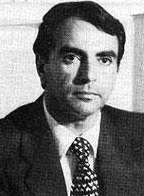Kamal Habibollahi
Mir-Kamaloddin Mir-Habibollahi[3] (Persian: میرکمالالدین میرحبیباللهی) (born 1930 Astara - died 2016 Reston) also known as Kamal Habibollahi (Persian: کمال حبیباللهی) was the last Commander of the Imperial Iranian Navy until the Islamic Revolution and was the last CNO under Pahlavi dynasty.[4] He also several held minister positions in the military government of Gholam Reza Azhari in 1978.
Kamal Habibollahi | |
|---|---|
 | |
| Minister of Culture and Art Acting | |
| In office 11 November 1978 – 22 November 1978 | |
| Monarch | Mohammadreza Shah Pahlavi |
| Prime Minister | Gholam Reza Azhari |
| Preceded by | Mohsen Foroughi |
| Succeeded by | Mohsen Foroughi |
| Minister of Education Acting | |
| In office 11 November 1978 – 22 November 1978 | |
| Monarch | Mohammadreza Shah Pahlavi |
| Prime Minister | Gholam Reza Azhari |
| Preceded by | Manouchehr Ganji |
| Succeeded by | Mohammad Reza Ameli Tehrani |
| Minister of Culture and Higher Education Acting | |
| In office 11 November 1978 – 22 November 1978 | |
| Monarch | Mohammadreza Shah Pahlavi |
| Prime Minister | Gholam Reza Azhari |
| Preceded by | Abolfazl Qazi |
| Succeeded by | Shamsoddin Mofidi |
| Personal details | |
| Born | 1 February 1930 Astara, Persia |
| Died | 11 October 2016[1] (aged 86) Reston, United States |
| Resting place | United States |
| Citizenship | Iran, United States |
| Nationality | Iranian |
| Father | Mir-Ketab-allah[2] |
| Alma mater | U.S. Naval War College Naval Postgraduate School Royal Naval Academy Officers' School |
| Cabinet | Military Government of Azhari |
| Military service | |
| Allegiance | Iran |
| Branch/service | Imperial Iranian Navy |
| Years of service | 1949–1979 |
| Rank | Vice admiral |
| Commands | Imperial Iranian Navy |
| Battles/wars | Dhofar Rebellion |
Early life
Kamal was born in 1930 in Astara. His father was Mir-Ketab-Allah, who was dedicated a land to build the «Mosque of Gharib al-Ghuraba» in Astara at 1910. He was buried at that mosque's yard.[2]
Career
He was a graduate of the Royal Navy Officer Program, U.S. Naval Post Graduate School, and U.S. Naval War College.
He rose through the ranks of the Navy and ultimately served as CNO, resigning his post upon the collapse of the Bakhtiar government. An outspoken critic of the incoming Khomeini regime and radical Islam, he was forced to flee the country.
In August 1981, he led a group of people loyal to a Free Iran in seizing the Tabarzin, an Iranian navy missile cruiser, off the coast of Spain, in order to draw attention to the continued resistance to Khomeini and Radical Islam.[5] After the revolution, he resided in the Washington D.C. area of the United States and continued to promote attention to free Iran causes, as well as warn against the dangers of global Islamic extremism and terrorism through speeches at universities, military academies, panels, and both US and Iranian media outlets.[4]
References
- "Darydar Kamal Habibollahi, last Navy commander of Mohammed Reza Shah, dies". Peter II, Khan-e-Mazendaran. 11 October 2016. Retrieved 15 December 2016.
- Neʻmat Allahī, Behrūz (2001). Tārīkh-e jāmeʻ-e Āstārā va ḥukkām-e Namīn (in Persian) (1st ed.). Ardabil: Nashr-e Sheykh Safī. p. 74. ISBN 964-6822-12-6.
- Neʻmat Allahī, Behrūz (2001). Tārīkh-e jāmeʻ-e Āstārā va ḥukkām-e Namīn (in Persian) (1st ed.). Ardabil: Nashr-e Sheykh Safī. p. Annex 27. ISBN 964-6822-12-6.
- "Documents detail Israel missile deal with the Shah", Elaine Sciolino, 1 April 1986, The New York Times.
- "Iran: Piracy, Protests And Polemics", David S. Jackson; Sandra Burton; George Russell, Time Magazine, 24 August 1981. Retrieved 11 January 2011.
| Military offices | ||
|---|---|---|
| Preceded by Abbas Ramzi Attaie |
Commander of the Imperial Iranian Navy 7 January 1976 — 11 February 1979 |
Succeeded by Cpt. Afsaripour |